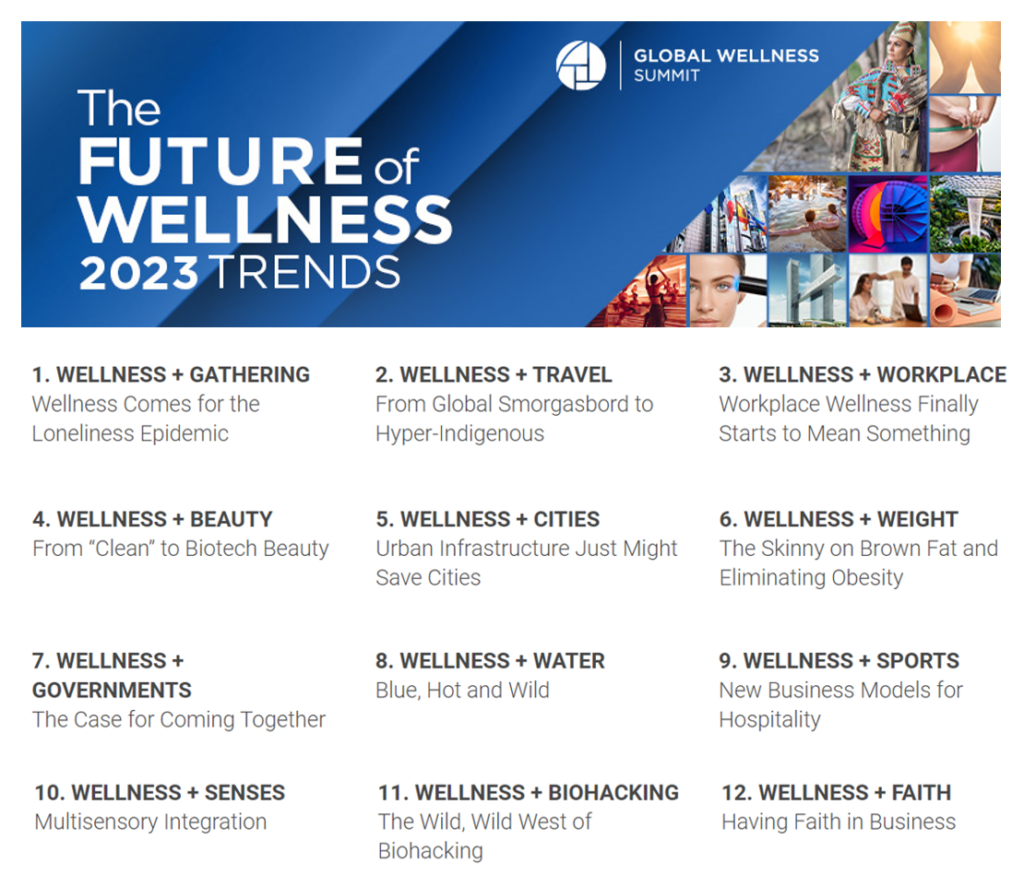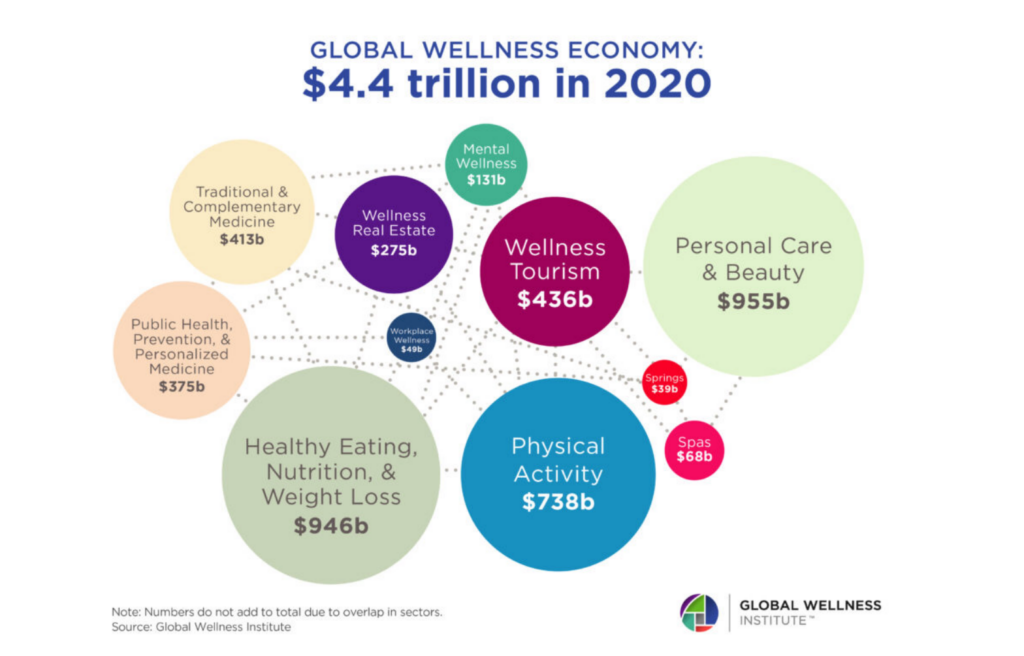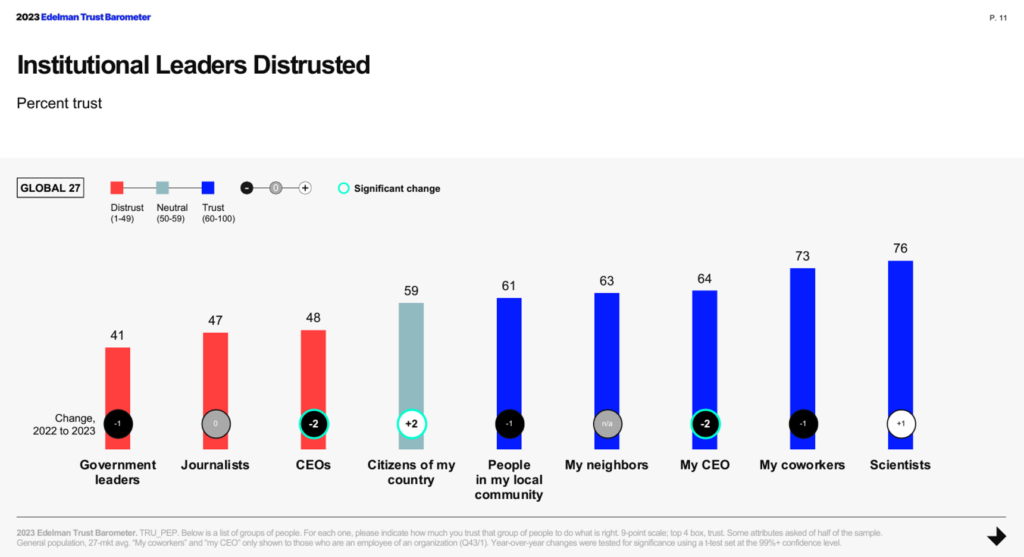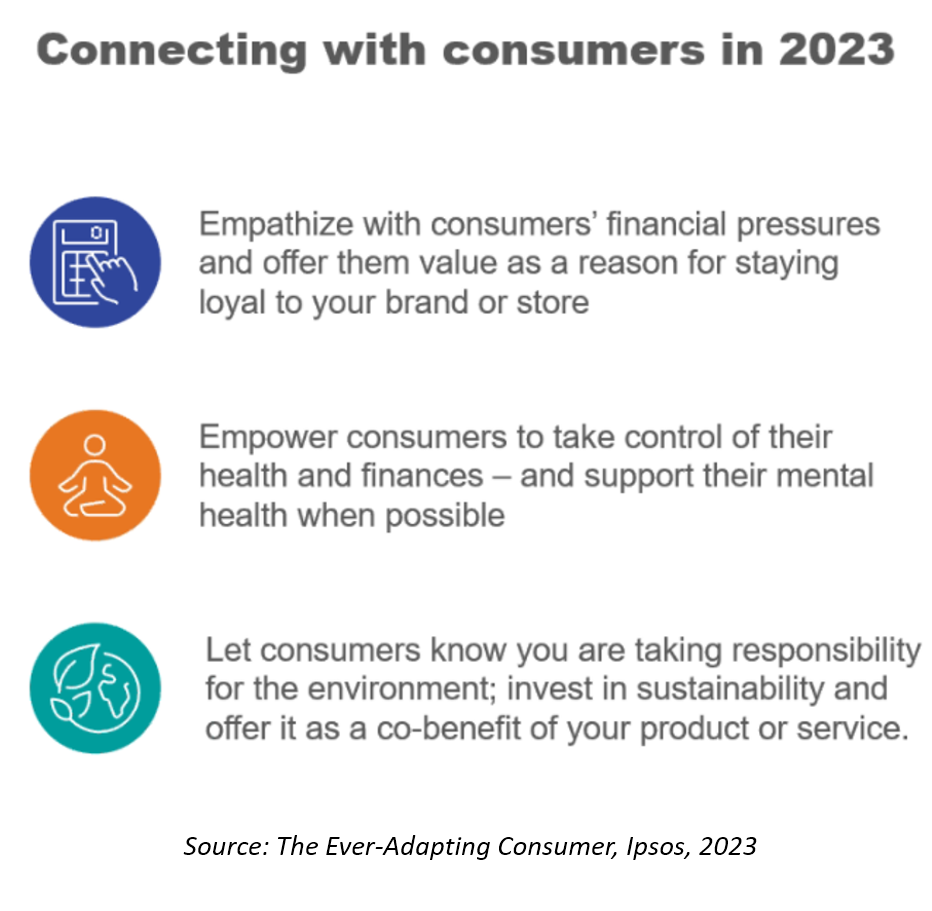Consumers’ wellness life-flows and demands in 2023 will go well beyond exercise resolutions, eating more greens, and intermittent fasting as a foodstyle. It’s time for us to get the annual update on health consumers from the multi-faceted team who curated the Global Wellness Summit’s annual report on The Future of Wellness 2023 Trends.

In this year’s look into wellness for the next few years, we see that health-oriented consumers are seeking solutions for dealing with loneliness and mental health, weight and hydration, travel-as-medicine as health destinations, and — not surprisingly — technology-driven approaches to biohacking, beauty, and what the report calls “multisensory integration” (explained below).
Two of the 12 trends deal with business and the workplace, illustrating the reality of the blur working people now have between their “9 to 5 lives” and home/social lives.
And one trend deals with wellness + governments: the case for coming together, which I’m keen on with my lens on health citizenship.

Even in a tough economy, consumers have made wellness a top priority, increasing personal spending on different health-and-wellbeing bets based on personal values and preferences. It’s a marketspace that the Global Wellness Institute estimated worth $4.4 trillion in 2020, as the bubble chart illustrates. GWI’s typology of wellness market segments covers a comprehensive landscape, in order of size:
- Personal care and beauty
- Healthy eating, nutrition and weight loss
- Physical activity
- Wellness tourism
- Traditional and complementary medicine
- Public health, prevention, and personalized medicine (specific to wellness applications)
- Wellness real estate, and
- Mental wellness.
Were GWI to re-calibrate this landscape today, post-pandemic, I would guestimate that the mental wellness bubble would be much larger, with personal care and beauty definitely bolstered in and in the wake of the pandemic.
What’s really new in the post-COVID consumer is that people are more science-oriented, more reflective, and many (especially younger health citizens) keen on “each other and the planet.” Think climate change, sustainability, and ESG as driving forces inspiring consumers to take on new and silo-busting wellness behaviors.
I highly recommend that you download and read the entire report which will expand your mindset about where and how wellness can be experienced, made, and shared. Here, I’ll weave three cross-currents that I’ll be incorporating in my scenario planning and other work this year (and ongoing)…
Making connections. Several trends embed peoples’ need to gather, to have human touch, to commiserate, to join and belong. Beth McGroarty speaks eloquently about the loneliness epidemic, which continues to plague some of us in different ways: still viscerally remembering or being conscious of physical distancing, for example, or avoiding going to the gym continuing our online fitness gatherings. “The future of wellness is a move from lonely to social self-care,” Beth writes, “buying to belonging, URL to IRL, ego to empathy, Goop to group.” This is reflected in how many people are choosing to travel and experience new places, head back to work, and look to governments for support in “coming together.”
Managing the work/life blur with balance and joy. While employers (particularly larger companies) have allocated serious resources for wellness programs, what that meant pre-pandemic feels quite different to workers-as-health-consumers in the wake of COVID. Certainly mental health and financial wellness are two pillars of overall wellbeing for which employees seek support from employers. But int he words of Skyler Hubier and Cecelia Girr, “workplace wellness finally starts to mean something.” A serious and challenging aspect of this separate from the pandemic is what healthcare and well-being looks like in a post-Dobbs world in the U.S. Women’s health, from growing fem-tech investment to family-friendly benefits will be key to attracting and retaining talent. Hybrid working from home and in the office IRL has created a blur in working peoples’ lives which without attention to guardrails, balance, joy and human connections, is a recipe for burnout and so-called quiet quitting.

Being Missourian in spirit and intent: seeking the science and the evidence. Whether looking at biotech beauty and what “clean” really means, effectively dealing with obesity, or biohacking our biology, wellness-engaged health citizens are not interesting in the shiny new thing without data backing up claims. Consumers continue to seek greater transparency and trusted voices to inform their decisions.
The 2023 Edelman Trust Barometer found that scientists are the most-trusted institutional leader this year, ranked above all other leader types. This is consistent with other studies from the past few years, as consumers’ faith in governments and media has dramatically eroded. Note that Edelman also re-asserted its discovery of the past couple of years that peoples’ employers are also relatively trusted sources of truth and facts — lending additional credence to the Global Wellness Summit emphasis on workplace wellness in this year’s trend report.

Health Populi’s Hot Points: In their 2023 read of The Rise of the Conscious Shopper, Ipsos paints a profile of consumers adopting a keener value orientation, recommending that organizations design and offer products and services that align with peoples’ demands to support future goals that benefit their physical and/or mental health.
People look at health well beyond their health care system, and this is particularly true for younger people who have taken to virtual care/telehealth services more readily and consistently than older patients. This is especially useful for the long-underserved and -supplied mental health and therapy market, which is persisting more consistently post-COVID and the public health emergency that telehealth for primary and urgent care.
As Ipsos reminds us and GWS’s report reinforces, more people want to feel more empowered when it comes to health across all dimensions — physical, mental, financial, spiritual.





 Thank you, Jared Johnson, for including me on the list of the
Thank you, Jared Johnson, for including me on the list of the  I am so grateful to Tom Lawry for asking me to pen the foreword for his book, Health Care Nation,
I am so grateful to Tom Lawry for asking me to pen the foreword for his book, Health Care Nation,  Thanks to Feedspot for naming this blog, Health Populi, as a
Thanks to Feedspot for naming this blog, Health Populi, as a